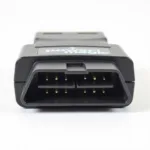The world of car audio has evolved significantly, with sophisticated infotainment systems becoming standard in even entry-level vehicles. However, upgrading these systems often means navigating a maze of wiring harnesses and compatibility issues. That’s where iDataLink OBD2 interfaces come in, simplifying the integration process and providing a seamless transition for your car stereo upgrade.
Why Choose an iDataLink OBD2 Interface?
iDataLink OBD2 interfaces are designed to retain critical vehicle features when upgrading your car stereo. By connecting to your vehicle’s OBD2 port, these interfaces retain steering wheel controls, factory amplifiers, backup camera functionality, and other essential systems that might otherwise be lost during an aftermarket installation.
Key Benefits of iDataLink OBD2 Interfaces:
- Simplified Installation: Say goodbye to complex wiring diagrams and time-consuming splicing. iDataLink interfaces offer plug-and-play solutions, minimizing installation time and potential errors.
- Vehicle Feature Retention: Retain valuable features like steering wheel controls, parking sensor chimes, and even climate control integration with certain models.
- Compatibility: iDataLink offers a wide range of interfaces compatible with various car makes, models, and aftermarket stereo brands.
- Sound Quality: Experience optimal sound quality by retaining factory amplifiers and minimizing signal interference.
Exploring iDataLink Maestro RR: A Flagship Interface
One of iDataLink’s standout offerings is the Maestro RR. This advanced interface not only retains essential vehicle features but also unlocks a host of customization options for your aftermarket stereo.
Key Features of iDataLink Maestro RR:
- Advanced Steering Wheel Control Programming: Customize your steering wheel controls to seamlessly operate your new stereo, including volume, track selection, Bluetooth, and more.
- Vehicle Data Display: Access vital vehicle information like tire pressure, battery voltage, and check engine codes right on your aftermarket stereo’s display.
- EQ and Sound Processing: Fine-tune your audio experience with built-in equalization and sound processing capabilities.
How to Choose the Right iDataLink OBD2 Interface
Selecting the correct iDataLink interface is crucial for a successful installation. Here’s a step-by-step guide:
- Visit the iDataLink Website: Utilize their comprehensive vehicle compatibility tool.
- Input Vehicle Information: Provide your car’s year, make, model, and trim level.
- Select Your Aftermarket Stereo: Choose the brand and model of your new head unit.
- Review Recommended Interfaces: The tool will generate a list of compatible iDataLink interfaces.
- Consult the Installation Guide: Once you’ve chosen your interface, download and review the installation guide for your specific vehicle and stereo combination.
idatalink maestro rr pioneer obd2 install guide
iDataLink OBD2: Elevating Your Car Audio Experience
iDataLink OBD2 interfaces have redefined aftermarket car stereo installations. They provide a user-friendly approach to upgrading your car audio system without sacrificing crucial vehicle features. With their commitment to innovation and compatibility, iDataLink continues to be a leading choice for both car audio enthusiasts and professional installers.
FAQs about iDataLink OBD2
1. Do I need any special tools to install an iDataLink OBD2 interface?
While basic hand tools are helpful, most iDataLink interfaces are designed for straightforward installation. However, referring to the provided installation guide is essential.
2. Can I still use my factory USB and auxiliary ports with an iDataLink interface?
Many iDataLink interfaces include provisions for retaining factory USB and auxiliary inputs. Check the product specifications and installation guide for details.
3. What happens if I need to visit the dealership for service after installing an iDataLink interface?
iDataLink interfaces are designed not to interfere with vehicle diagnostics. However, it’s good practice to inform the dealership about the aftermarket stereo installation.
Common iDataLink OBD2 Scenarios
Scenario 1: Retaining Steering Wheel Controls
A common concern when upgrading a car stereo is losing the convenience of steering wheel controls. iDataLink interfaces address this by integrating seamlessly with your vehicle’s existing steering wheel control system, allowing you to maintain control of essential functions like volume, track selection, and phone calls.
Scenario 2: Preserving Backup Camera Functionality
Modern vehicles often come equipped with backup cameras for enhanced safety and convenience. When upgrading your car stereo, it’s crucial to retain this feature. iDataLink interfaces ensure that your backup camera functions seamlessly with your new aftermarket head unit, providing uninterrupted rearview visibility.
Need More Information?
For further assistance, feel free to explore our other informative articles or reach out to our dedicated customer support team.
Contact Us:
WhatsApp: +1(641)206-8880
Email: [email protected]
Our team is available 24/7 to answer your questions and guide you towards the perfect car audio solution.


